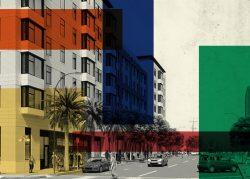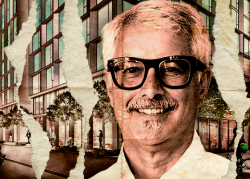Joel Engardio knows that, in the beginning, most people thought his fourth bid to be a San Francisco Supervisor was a lost cause.
After all, no challenger had beaten a sitting supervisor in more than two decades. Redistricting helped, moving Engardio’s home near Stern Grove from District 7 (Inner Sunset, Golden Gate Heights, West Portal) into District 4 (Central and Outer Sunset, Parkside). But, as Engardio put it, he couldn’t have beaten incumbent Gordon Mar on redistricting alone.
“It was the incumbent’s to lose; he’d been there for four years, he should have cleaned up and had a vast majority of votes in the heart of the district,” he said in an exclusive interview with TRD.
The upset should be a lesson to other established politicians in San Francisco, he said. Engardio helped lead the school board recall and supported the district attorney recall — both successful — which had even stronger support in District 4 than it did citywide. Mar was against both recalls, he said, and being out of touch with his constituents led to his loss.
“Incumbents will be at risk if they defy the will of the residents, and District 4 was a great example,” Engardio said. “He was against the majority of the voters on the two issues that they cared most about: public safety and education.”
Those were the two causes that Engardio pushed most during his campaign, but his pro-housing development stance was also different from Mar’s, earning him endorsements from several YIMBY groups.
“Mar said explicitly on multiple occasions that he did not believe that the lack of dense housing was a cause of the housing crisis,” SF YIMBY’s Robert Fruchtman said via email. ”I expect Supervisor Engardio will support more density on the west side. I think he understands that density isn’t a goal but a prerequisite for San Francisco to end its housing crisis.”
Engardio spoke with TRD about bringing density to his underdeveloped west side district, as well as why change on land use policy will only come if San Francisco voters begin to parse out the different shades of blue among their candidates.
You were inaugurated in January, just as the housing element process was coming to an end. What comes next?
Even though we passed an element, that was actually the easy part. The hard part is the implementation. So as difficult as it was to even come to consensus about passing an element that would satisfy the state requirements, it’s entirely another thing to actually make it happen. My hope is that people will see that it was nothing to be afraid of in the first place.
How are those battles over density and height going to play out as we get into the implementation stage?
The key is meeting people where their needs are. A longtime resident of the Sunset might realize that their adult child or grandchild can no longer stay in the city, and they’d like to have access to their grandchildren. So they might be more open to more dense housing that their family can stay in.
If you look at the west side of the Sunset in particular, there are some Art Deco apartment buildings that have been there for 100 years that are seven stories tall. Those buildings have been coexisting with the single-family homes for a century, we just stopped building them. People talk about neighborhood character, and you can’t get more neighborhood character than a building that has defined the neighborhood for a century. So I think we can match what has been there for 100 years. That’s absolutely reasonable and it’s going to increase the density along those transit corridors.
Since you are new to the board, when can we expect to see some votes that let us know where you stand on housing development and how you differ from your predecessor?
I can’t think of anything coming up like in 2021, when we had the famous Stevenson Street project on the old Nordstrom parking lot, that the moderate Democrats wanted to make housing and the progressive Democrats said no to. Market-rate housing is good, because it generates the fees that can be used to build affordable housing. So by killing off that market-rate project, we killed 400 market-rate units, but we also killed 100 affordable units. I don’t know how that serves the best interests of our city, especially when we need houses for teachers, firefighters and middle-income workers. So I don’t see a Stevenson-level project on the ballot or that I’ll be voting on immediately.
My predecessor voted to kill housing on the Nordstrom parking lot. I would have voted for it. So we’re pretty much just opposites.
It’s easier to vote for development downtown, but how about in your own district? We see a lot of pushback to the affordable housing development proposed on Irving Street.
I support the development on Irving Street. There’s one caveat: unfortunately, because there was a longtime dry cleaner and mortuary on that site, toxic waste has seeped into the ground and nearby homes. So I just want to make sure that’s fully mitigated, but we should build.
When you were running your campaign, your focus was on crime and the school board. How are some of the changes that you were trying to make, as far as public safety and schools, related to housing?
Housing is important, but it doesn’t matter if people don’t feel safe and families are leaving the city because they don’t feel the schools are good. So I’m going to do everything I can to improve our housing situation, but I’m going to keep my eye on the ball when it comes to public safety and education.
Everything in San Francisco is related to housing, because we’re on a seven-by-seven-mile peninsula, a tiny geographic patch. Every elected official is a Democrat, so we’re aligned on all the national issues that liberal Democrats care about. But we fight about land use. Do we want to preserve the city in amber, and keep it the way it was for a generation who came here in the ‘70s? Or do we evolve and change the city for the next generation? So that’s the epic battle that we’re seeing right now.
Another issue that comes to mind is the conservatorship for the mental health crisis we have in our streets. The moderate Democrats tend to support stronger conservatorship laws to compel people to get the treatment they need because I don’t believe it’s progressive to let people suffer on the street. But progressives tend to not want to strengthen conservatorship laws. So that’s a clear dividing line between the moderate and progressive Democrats in San Francisco.
If we’re stuck in this political bifurcation, even though everyone’s a Democrat, what can we do to make sure that housing actually gets built in the city?
Well, elections matter, right? Because the configuration of the Board of Supervisors who rejected housing on an empty parking lot was determined by the voters. So if the voters want that housing to exist, they need to elect different supervisors. They did in this cycle; myself and Supervisor Matt Dorsey are the two new additions, and we’re both pro-housing. We have to change the configuration of the supervisors if we want to move the needle on any number of issues, whether it be public safety or housing.
Do you see more moderate Democrats gaining steam in the city?
The school board and district attorney recalls were defining moments in San Francisco history. My election was part of that momentum, because no one expected someone to oust an incumbent. We’ll see if that momentum continues in the next election cycle. I feel like everyone’s frustrated in San Francisco, but the voters are realizing they do have the power to make that change.
People are not aware of who they are voting for when everyone’s a Democrat. I think people are finally realizing that in San Francisco politics, you have to approach every local election like it’s a national presidential primary. Are you voting for a Bernie Sanders Democrat or a Pete Buttigeig Democrat or a Kamala Harris Democrat? You need to know the difference. And we do, nationally, but we don’t know locally. People are finally realizing that we need to have that level of education and understanding, whether it’s the school board or the Board of Supervisors. What type of Democrat are you voting for?
What did it mean for you to become a homeowner in a city where that’s so difficult?
We skated in just before the window closed for us to be able to buy a home because we bought in 2014. [Engardio married software engineer Lionel Hsu in 2015 and is the first openly gay politician to represent a west side district.] So not at the bottom of the market, but certainly in a better spot than we are now. We jumped because we saw the bottom hit and things were starting to come up pretty quickly. So by 2014, on the upswing, we jumped in. I’m glad we did, because I don’t think we’d be able to at this point.
Is there anything more that you can do as a supervisor to address affordability concerns for those who have been priced out in your district?
We have to acknowledge that we have a housing shortage and a housing crisis because we have not built enough housing for the last half century to meet population growth and job growth. We need to do better in creating more supply.
Would you be open to lowering fees for developers and lowering inclusionary rates if it meant that more housing might get built?
If fees are too high, and nothing is happening, we have to reconfigure. Absolutely.
There are always the folks who want no housing, but I also hear from people who are realizing how more housing could actually benefit them for the needs that they have in their life right now. I hear from all sides every day.
Read more


